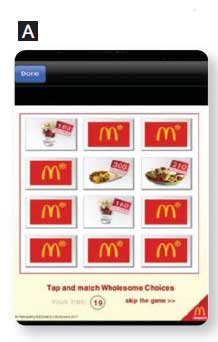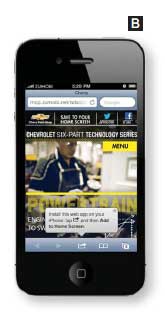The Acrobatics of Mobile Ad Design

By Amberly Dressler, Managing Editor
Swipes, tabs, scrolls and flips - mobile advertising offers unparalleled opportunities to deliver brand messaging in rich and interactive ways.
Anne Hunter, SVP of global marketing strategy at comScore says brands must embrace mobile ad units that not only encompass those activities, but also bring them to the forefront in rich canvasses that effectively deliver brand messages.
Many brands and agencies are responding to this demand and not just repurposing or shrinking down a banner ad from the Web to work on a mobile device, which of course results in losing detail. Instead, innovative companies understand the key differences of how consumers use phones differently than PCs, as well as mobile's opportunities and limitations.
The Judges
There are numerous best practices to leverage when it comes to mobile ad design. Two that immediately stand out to Joe Lazslo of the Interactive Advertising Bureau are to make sure the brand is prominent enough so that with just one glance, a consumer can tell who the company is and, two, that the message is very simple.
To Lazslo, however, the real exciting opportunity in mobile ad design is not so much what you can pack in the banner ad, but what happens once a user clicks.  For example, an ad can start as a banner advertisement, but then expand to take up a full screen, where there are games, shopping experiences, store locators or other highly interactive content. For example, a 2012 banner ad promoting McDonald's oatmeal was an expandable ad that invited users to play a Memory Game. Users clicked the titles to match the ingredients (see image A). They could then play again, find a local store or visit the McDonald's mobile website.
For example, an ad can start as a banner advertisement, but then expand to take up a full screen, where there are games, shopping experiences, store locators or other highly interactive content. For example, a 2012 banner ad promoting McDonald's oatmeal was an expandable ad that invited users to play a Memory Game. Users clicked the titles to match the ingredients (see image A). They could then play again, find a local store or visit the McDonald's mobile website.
In July 2013, IAB added five new Mobile Rising Stars formats to help companies move beyond standard mobile banner ads to drive greater user interaction and deliver higher brand and message recall.
With the release of these new formats came telling findings from an in-market study conducted in partnership with Vibrant Media and comScore. IAB's Mobile Rising Stars formats inspired almost twice the number of people to slide, swipe or tap than standard banners and a dominate 98.1 percent of consumers who interacted with a Mobile Rising Stars ad recalled the brand, and were 18 percent more likely to remember the advertised brand name than consumers who viewed a standard mobile banner ad. Many of these Rising Stars use natural touchscreen gestures like swiping to engage users, which fixes a major issue of mobile ad design - accidental taps.
"Buttons are small and our fingers are big, so by moving toward a world where ads say 'swipe me' instead of 'tap me', we're finding ways to make sure consumers really intended to interact with an ad, which leads to higher engagement metrics," said Lazslo.
The Technique
Despite its youth, the mobile advertising space has already seen major changes and what is a rising star for one, may not be for another. For example, today, Zumobi is seeing a much deeper engagement with native mobile campaigns that are organically integrated into host apps or content experiences and offer applike functionality, rather than typical mobile ads.
Features like advanced social media interoperability and access to phone hardware, like the camera roll or user's calendar, are example features that are now possible thanks to native mobile platforms like Zumobi's ZBi (Zumobi Brand Integration).
The ZBi platform was used for a Chevrolet Technology Series campaign (see a demo here), which was a content advertising experience that ran across Motor Trend's print magazine, website, iOS and Android Apps. People spent as high as 6.4 minutes interacting with the Chevrolet ZBi ads and had a low 4 percent bounce rate. Chevy's advertisements weren't presented as in-app banners. Instead, ads displayed like new content channels that captured user attention and subtly integrated brand messaging. Chevy and Zumobi also time released new content chapters to engage users further.
 The additional content gave users a good reason to use Zumobi's Footprint feature, which creates a leave-behind app on their mobile device home screens, so they can revisit the content at any time. Nearly 7 percent of users saved the integrated content experience to their home screen using this feature (see image B).
The additional content gave users a good reason to use Zumobi's Footprint feature, which creates a leave-behind app on their mobile device home screens, so they can revisit the content at any time. Nearly 7 percent of users saved the integrated content experience to their home screen using this feature (see image B).
Perfect Landing
Given the dramatic shift of audience consumption from traditional media to mobile devices (Pew Internet says 56 percent of American adults are now smartphone owners), mobile should be a core strategic element of any campaign. Thanks to organizations like IAB and platforms like Zumobi, designers can start thinking beyond clicks and display ads to create a truly immersive experience, enabling mobile ad design to invite consumers to interact with brands in new, personal ways.
And, since mobile devices are in consumers' hands and ads can now respond to movements such as turns and twists, mobile ad designs are inviting to both endusers and brands.

Subscribe to Our Newsletter!
Latest in Web Design








